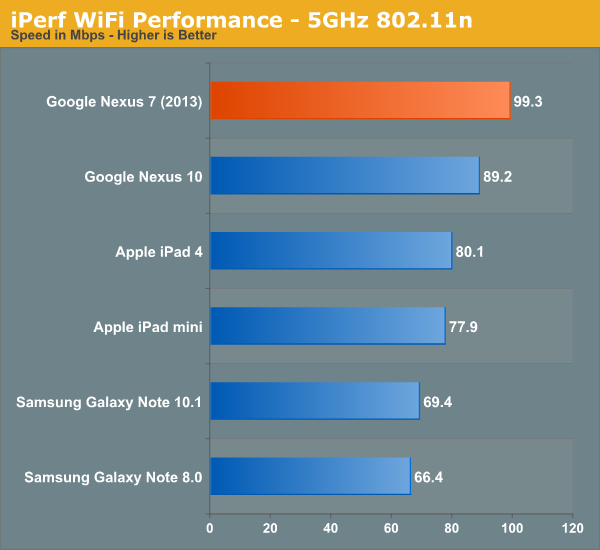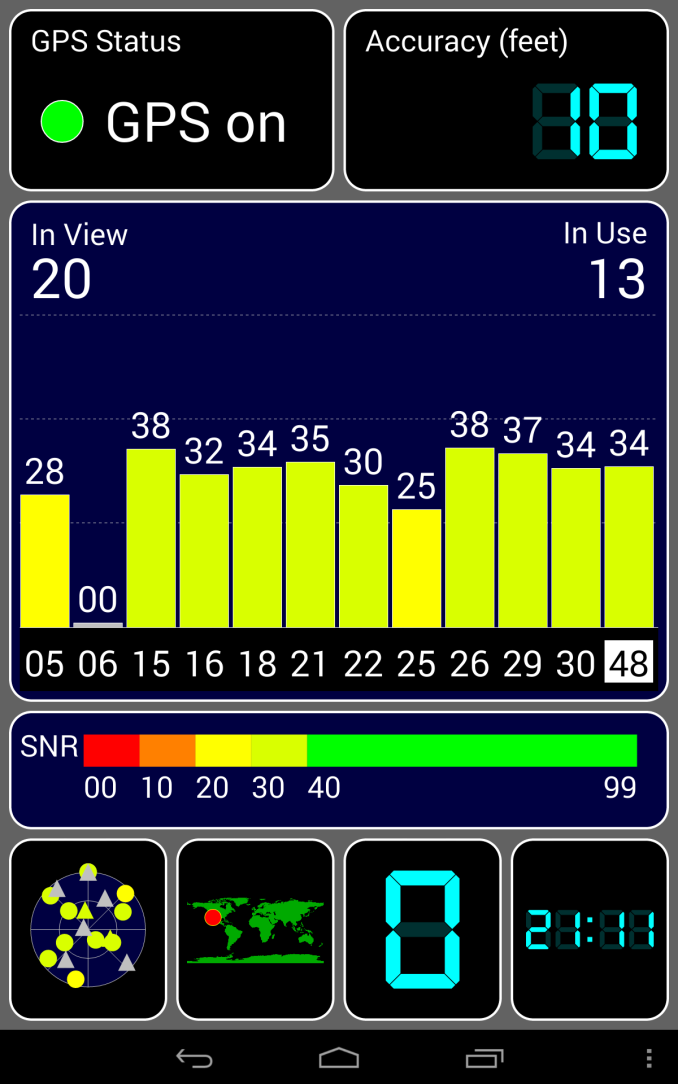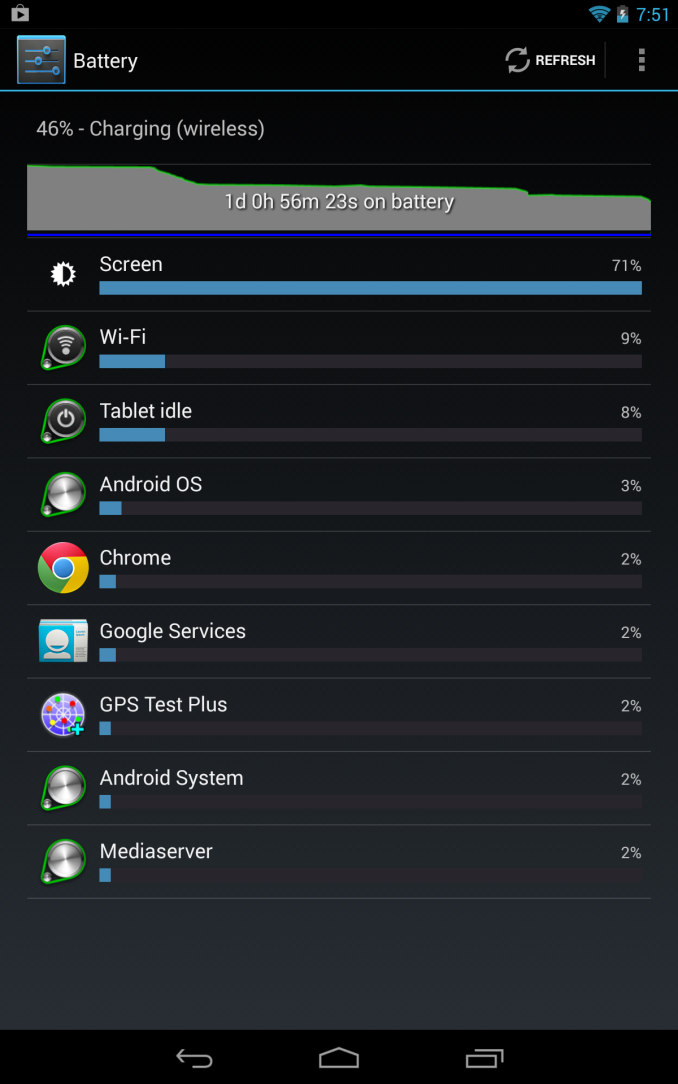Nexus 7 (2013) - Mini Review
by Brian Klug on July 27, 2013 12:54 AM EST- Posted in
- Tablets
- Snapdragon
- Qualcomm
- Android
- Mobile
- APQ8064
- Nexus 7
- Android 4.3
One of the biggest complaints I had about the original Nexus 7 was connectivity, as it only included 2.4 GHz 802.11b/g/n support. The hilarity of that situation was only compounded by the fact that Google could only demo the Nexus 7 at that Google I/O plugged in through USB-OTG Ethernet adapters because 2.4 GHz is effectively impossible to use at conferences. With the new Nexus 7, dual band (2.4 and 5 GHz) WLAN is now included with a WCN3660, Qualcomm’s companion WiFi 802.11a/b/g/n, BT 4.0, and FM Tx/Rx combo (though FM features aren’t enabled on the Nexus 7 2013).

Performance is correspondingly improved, and if you’re in an urban area where 2.4 GHz is congested beyond use, this makes the difference between an unusable brick and working tablet. Many have asked, why not WCN3680 (the 802.11ac enabled successor to 3660), the answer is of course, you’re talking about a ~$200 tablet, stuff like this understandably has to be n–1 without making the bill of materials untenable.
There’s also GNSS (GPS+GLONASS) on the WiFi only model which I tested, this goes through WCN3660 and into the baseband on APQ8064 in this configuration I believe. I’ve had nothing but great success with Qualcomm’s GNSS being the fastest out there to 3D cold fix, that holds true with the Nexus 7 (2013), even walking around the urban canyon scenario that San Francisco poses to GNSS.
Charging
The Nexus 7 (2013) is Qi (pronounced: “chee”) enabled, the de-facto wireless charging standard of the now. The Qi charger area is dead center in the middle, using a coil inside of the NFC one. That makes positioning easy.
I tossed the Nexus 7 on my Energizer Qi two-position mat when I got home, and it works perfectly, of course Qi can only charge at up to 5 watts. The in-box supplied charger is a 1.35 A variant, which isn’t anything special. Connected to my special linear power supply and battery charge downstream port controller which negotiates the proper standard, I saw the Nexus 7 (2013) draw a max of 1.32 A (6.6 watts), which makes sense given the supplied charger. I don’t have a 0–100 percent charge time number yet.












252 Comments
View All Comments
Roland00Address - Saturday, July 27, 2013 - link
The only thing this mini review is lacking compared to a normal review is the battery tests, that and the writer felt rush but Brian did a great job with such limited time.thesavvymage - Sunday, July 28, 2013 - link
Anand will personally be doing an incredibly in-depth analysis of nearly everything this tablet has to offer in the near future. You should go look up one of anand's iPad reviews, they are probably 3 or 4 times as long as this one. He does an amazing jobchrone - Saturday, July 27, 2013 - link
Great reviews as always. Does it still have transition animation micro stuttering when autobrightness is on and in outdoor?psyside1 - Saturday, July 27, 2013 - link
Can anyone tell me, is the unit tested 16 or 32GB version? i never saw clarification about it, which is the only thing missing in this review, other then that fantastic job.Also how much faster should the 32GB model be, if this one was 16GB version? (knowing flash benefit from size) 16 vs 32GB, might be nice to see for the future Anand review.
Krysto - Saturday, July 27, 2013 - link
Why would flash benefit from size? Either way, there shouldn't be major differences in speed.psyside1 - Saturday, July 27, 2013 - link
Why bigger SSD/USB drives, are always faster then smaller?Krysto - Saturday, July 27, 2013 - link
They might, but I doubt it has anything to do with the size, and more with the manufacturer's "strategy" of making higher store that is more expensive, also have higher speed.But that's like saying cameras with more MPs are automatically better because they have more MP's, when in fact they are usually better because the camera makers work in parallel to also improve the overall quality of the camera module, while increasing the MP count, too, for the next generation cameras.
Death666Angel - Saturday, July 27, 2013 - link
You should educate yourself on that one, your first statement is clearly wrong. The way SSDs get their exceptional speed is by using packages of NAND in parallel. And how many packages of NAND an SSD has directly corresponds to the size of the SSD. Look up a few reviews of SSDs on Anandtech and you will get a break-down of packages vs size, the one of the 840 EVO being a great example to study because of the inclusion of all sizes. It is not just an arbitrary decision to justify the price tag. The explanation is in the technology, not in the marketing this time.psyside1 - Sunday, July 28, 2013 - link
http://www.anandtech.com/show/6130/the-16gb-nexus-...How about you educate your self, instead of me? thanks.
Bast - Sunday, July 28, 2013 - link
Actually he's right. your link is not relevant as the eMMC devices most probably use only one chip and no parallel controller like SSDs do. In addition, in HDDs, the higher storage is because of higher densities of data on platters that rotate at the same speed as lower capacity drives which translates to higher rates.